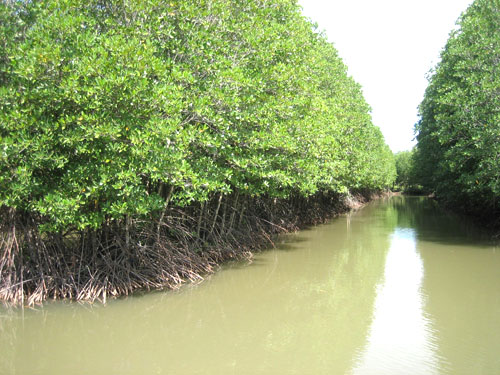The Vietnamese marine systems have been in a high danger, caused by the natural calamities and the human development activities.
 |
Vietnam’s territorial waters merge a variety of ecosystems -- from mangrove forests, coral reefs, lagoons, estuaries, to the offshore islands and deep sea ecosystems. However, the ecosystems may disappear one day due to the overexploitation, the pollution from the industrial production, sedimentation and the pollution from oil spills.
A report showed that 62 percent of the total mangrove forests in Vietnam are the newly planted ones, which have low quality in terms of size, length of the trees and variety diversification. Meanwhile, primeval mangrove forests no more exist.
The forest degradation can be seen most clearly in the sharp decline in the area and quality of mangrove forests. In 1943, Vietnam reportedly had 408,500 hectares of mangrove forests, while the figure dropped to 209,741 hectares in 2006, most of which were newly planted.
The mangrove forest loss has caused serious damages in terms of biodiversity. As the mangrove forests have lost, aquatic creatures have lost the places for laying eggs, while water birds have lost the homes. Especially, with no mangrove forests, the rice fields have suffered from the salinity intrusion, while the “embankments” to prevent from coastline slide, from pollution and storm wind have no more existed.
Geographical documents show that coral reefs have been found mostly in the coastal areas around the islands on the continental shelf, including the Co To archipelago, Ha Long – Cat Ba, Bach Long Vi and Cu Lao Cham islands, Van Phong and Nha Trang Bays, In Ninh Thuan province, Ca Na Bay, Phu Quy island. They have been seen in on Con Dao, Phu Quoc, Nam Du islands and the two offshore archipelagos of Hoang Sa and Truong Sa.
However, the coral reefs have been reportedly in bad situation. The surveys conducted in the years from 2004 to 2007 in the seven most important coral reef areas of Vietnam, showed that only 2.9 percent f the coral reefs were in very good development conditions, 11.6 percent in good conditions, while 44.9 percent in bad and very bad conditions.
The decline in the coral reef area has led to the decline in the biodiversity, because the organisms living in coral reefs as fish, crustaceans, mollusks, have lost their homes.
Seagrass beds are the important food sources for aquatic creatures. Scientists say the number of species residing in the seagrass area is always higher by 2-8 times than the other waters.
Especially, this is the place where Dugon, a kind of rare and precious sea animal, lives and seeks food.
The seagrass beds are situated at the depth of 0-20 meters, mostly seen on the Phu Quoc Island and at some estuaries in the central region.
According to the scientists from the Institute for Natural Resources and the Environment, by 2009-2010, the seagrass bed area had been 212,380 hectares. The seagrass has been lost gradually because people have been trying to encroach on the sea, digging ponds for fish farming. The scientists believe that the seaweed area has decreased by 40-70 percent.

Leave your comment on this story